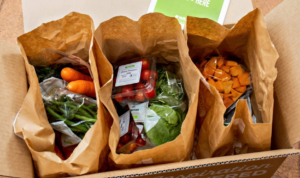We’re seeing more and more investors embrace our investment strategy: buying undervalued stocks under 10 euros with serious upside potential. The stock Rolls-Royce, on which we’ve achieved nearly 1,000% gains, is clear proof that you can turn a nickel into a dime.
In this update, we provide a clear overview of the positions we currently hold in the Sharesunderten.com portfolio. For each stock, we explain:
- Why we originally bought the stock
- What developments have occurred since then – in terms of company performance or market news
- And why we currently see no reason to sell these positions
We remain committed to our approach: selective, disciplined, and focused on medium- to long-term returns. Time is our ally. Stocks under ten euros often have the most room for recovery or revaluation – if you know where to look.
If certain stocks have already risen significantly, you’re still welcome to follow our updates, and of course, invest alongside us in those positions that are still active buys for new subscribers.
Let’s start with our first position…
- BP
- Deceuninck
- Rolls Royce
- Grab Holding
- Hello Fresh
- Brunel
- Centrica
- Playtech
BP
On May 19, 2021, we took our first position in BP when the share price stood at 310 pence. We bought 1,250 shares for the Sharesunderten portfolio, convinced of the recovery potential of this British energy giant. At the time, oil prices had begun to rise again after the pandemic-induced low in 2020, but BP’s share price had barely followed suit. Nonetheless, we saw clear signs of recovery: management announced debt reduction, a share buyback program, and a total cash return to shareholders of 8 to 11% starting in 2022—significantly more than sector peers.
In addition to strong shareholder returns, BP also began taking a leading role in the energy transition. The new CEO, Bernard Looney, announced a structural reduction in oil and gas production and a transformation into an integrated energy company. BP committed to investing $5 billion annually in sustainable initiatives, including solar and wind energy, hydrogen, and biofuels. BP became the first oil major to publicly acknowledge that peak oil demand was behind us.
We held the position for three years. In May and June 2024, we sold our shares in two tranches, realizing a total return of about 70% including dividends. The timing proved excellent: shortly after our sale, the share price corrected slightly. This also gave us an opportunity to re-enter at lower levels. In January 2025, we re-initiated a position at 434 pence, using 60% of the original investment volume. We had already expressed our intent to buy more on a correction and followed through in early May at 360 pence.
Our renewed confidence in BP is based on two factors. First, the valuation remains attractive, with a P/E ratio just above 7 and a dividend yield of 6.4%, potentially rising to 7.4% by 2027. Second, BP is making significant progress in its transition to a low-carbon energy company, with a strong focus on hydrogen. Projects like Lingen Green Hydrogen aim to put BP at the forefront of a market estimated to grow to $259 billion by 2033.
BP’s financial foundation is solid. In Q3 2024, it generated $6.8 billion in cash flow and even raised its dividend despite pressure on refining margins. With free cash flow expected to rise toward 20% in the coming years, there is room for both investments and shareholder rewards.
We expect BP to rise in the short term toward 550 pence, a price target aligned with profit and cash flow growth forecasts. Over the longer term, we believe BP is well positioned in both fossil and renewable energy markets. BP combines operational strength with a clear long-term strategy, and as long as that remains the case, we want to remain invested.
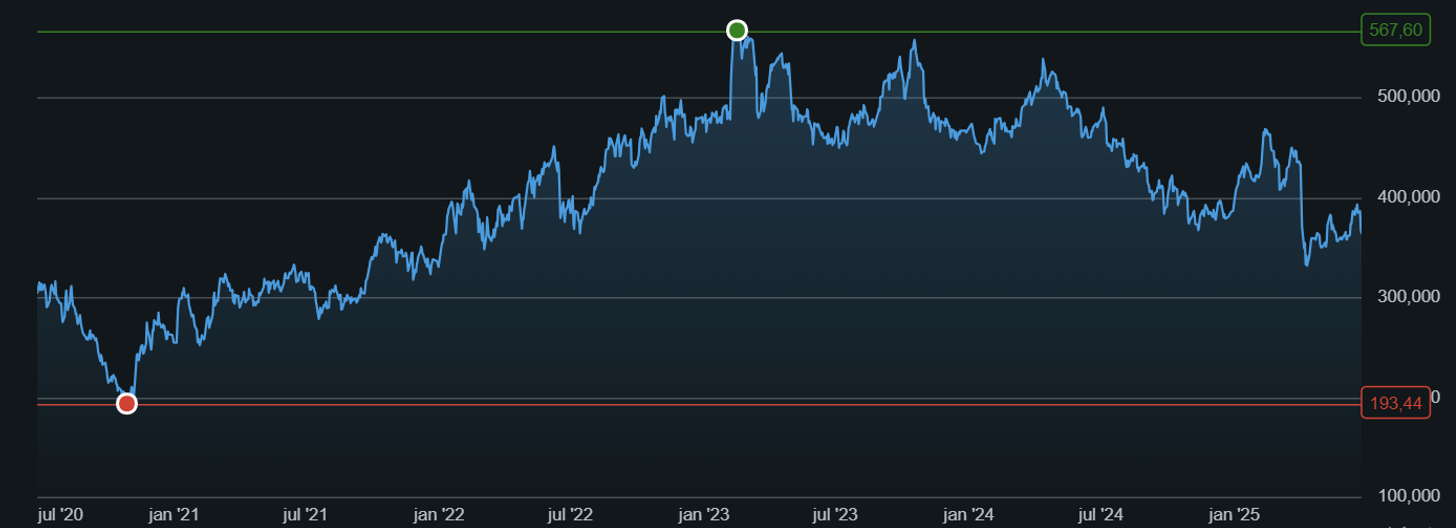 BP share price performance over the past five years.
BP share price performance over the past five years.
Deceuninck
On May 31, 2021, we initiated a position in Deceuninck at €2.94. The timing proved excellent. The Belgian manufacturer of PVC window and door profiles benefited greatly from the European renovation wave, driven by sustainability subsidies and higher home investments during lockdowns. Deceuninck returned to profitability, reduced debt, and made substantial investments in product development and a recycling plant. The share price rose quickly, and when majority shareholders Willy and Arnold Deceuninck announced a private placement of their stake, we decided to exit completely on September 14, 2021, realizing a nearly 30% profit. Large placements often signal a pause in upward momentum, which proved correct.
However, we re-entered the stock on August 18, 2023, at €2.27, buying 1,250 shares for our portfolio. What caught our attention: despite a 10% price drop over the past year, the share price of Ege Profil—Deceuninck’s Turkish subsidiary in which it holds an 88% stake—had more than tripled. That stake alone was worth around €340 million, while Deceuninck’s total market cap stood at €321 million. In other words, investors were attributing a negative value to all other activities of the Belgian parent company.
At the same time, management reiterated its 2023 guidance: EBITDA growth and improved free cash flow. No profit warning was issued, and the results released in late August confirmed the company’s resilience in a challenging market.
We continue to hold Deceuninck firmly in our portfolio. The company benefits from a strong competitive position due to its franchise-like sales model, which ensures customer loyalty, pricing power, and margin protection. The balance sheet is also healthy, with net debt of just €88.3 million on nearly €1 billion in revenue by the end of 2022. Investments in recycling and circularity align perfectly with long-term trends in the construction and renovation sectors. And last but not least: the hidden value of Ege Profil is still not fully reflected in the share price.
We believe management has several strategic options to unlock this value—such as selling the Turkish stake or initiating a share buyback program. As long as this option remains open and cash flows remain intact, Deceuninck remains a buy for us. We are staying on board, awaiting the next catalyst.
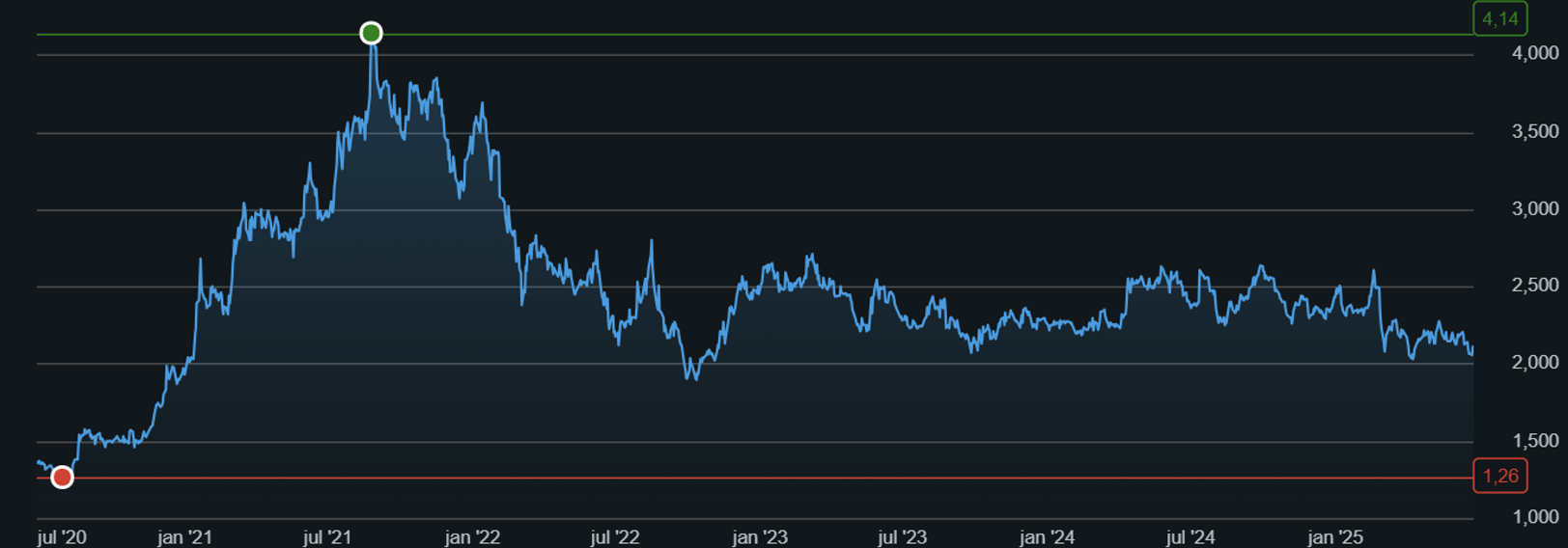 Deceuninck share price performance over the past five years.
Deceuninck share price performance over the past five years.
Rolls-Royce
On April 6, 2022, we added Rolls-Royce to our Sharesunderten portfolio at a price of just 97 pence. We bought 2,000 shares and saw in this British industrial giant a classic recovery story despite market concerns. At that time, Rolls-Royce was the epitome of a neglected value stock—well-known by name, but struggling with the aftermath of the pandemic, disappointing cash flows, and rumors of a £2.5 billion rights issue. The aerospace division was running at minimal capacity, and the stock had hit a 16-year low. Still, we noticed something the market seemed to overlook.
On May 13, 2022, we increased our position by purchasing an additional 1,000 shares at 83 pence. With the current share price at 930 pence, our initial investment has risen by over 850%, and the secondary purchase by more than 1,000%. That kind of recovery is no coincidence.
Despite negative sentiment, nearly one-third of revenue came from the defense sector—a more stable and profitable business. Additionally, Rolls-Royce possessed valuable technologies, such as for nuclear submarines, and its engineering expertise paved the way for innovations like small modular reactors (SMRs). These SMRs produce about 470 megawatts per unit—much less than large nuclear plants, but at a fraction of the cost. The UK government considers this technology strategically important and holds a “golden share” in Rolls-Royce, allowing it to block hostile takeovers. This makes Rolls-Royce a unique defensive growth opportunity in a world where energy security and military readiness are increasingly prioritized.
Global defense budgets have soared, and the UK Ministry of Defence continues to invest in naval nuclear technology. The energy transition has also gained momentum: nuclear energy is once again seen as indispensable, and Rolls-Royce is one of the few companies with a scalable, realistic SMR solution. Meanwhile, new management sharpened the company’s focus and sold off non-core assets. These strategic choices are now paying off.
We’re holding onto this stock tightly. Rolls-Royce benefits from multiple long-term trends—energy independence, defense spending, and the revaluation of nuclear energy—that are likely to persist for years. We consider it a success story whose full potential has yet to be realized.
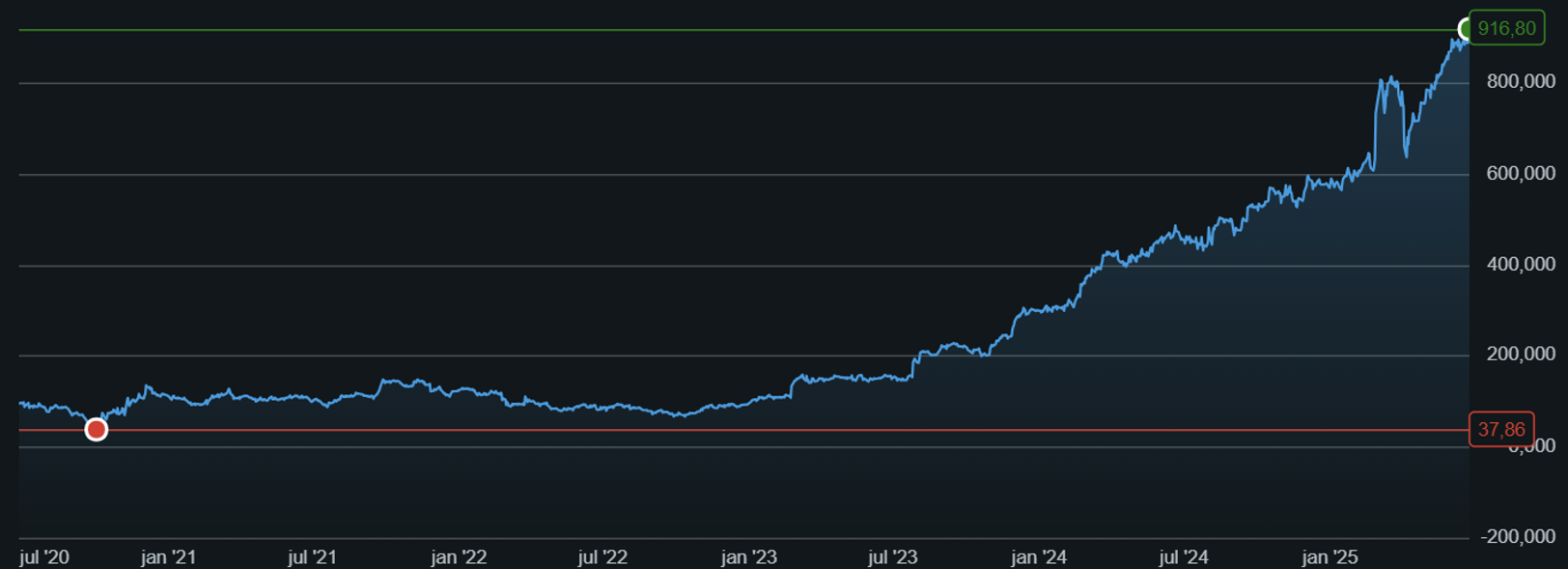 Rolls Royce share price performance over the past five years.
Rolls Royce share price performance over the past five years.
Grab Holdings
On January 18, 2024, we took our first position in Grab Holdings at a price of $2.92. The stock had been under heavy pressure after a nearly 80% decline since its IPO in 2021. Yet we saw opportunity: Grab had significantly reduced its operational losses, adjusted EBITDA turned positive for the first time, and the company held a strong cash position. While the market remained skeptical, we identified a classic recovery story with a strong base in growth markets.
In July 2024, we exited the position after the company abandoned its acquisition of Trans-cab Holdings, Singapore’s largest private taxi company. The deal was blocked by the competition authority, raising concerns about Grab’s domestic growth potential. Not wanting to take unnecessary risks, we locked in a solid 14% gain.
We kept a close watch. Grab’s strategic positioning in Southeast Asia, combined with a strong brand, solid balance sheet, and ongoing operational improvements, remained attractive. When the company raised its EBITDA forecast and posted strong quarterly results on May 19, 2025, we re-entered with 300 shares at $5.07.
Grab has since evolved into Southeast Asia’s super app. With services in Mobility, Deliveries, and Financial Services, the company serves over 500 cities across eight countries. These segments represent 37%, 54%, and 9% of revenue, respectively. Mobility is profitable with an EBITDA margin of 54%, while Financial Services is the fastest-growing division (+44% in 2024), albeit still unprofitable.
The balance sheet is extremely strong: Grab holds $5.9 billion in cash against only $0.4 billion in debt—resulting in a net cash position of $5.5 billion, unusually robust for a young growth company. Tangible book value stands at $1.32 per share, offering a strong floor for the share price.
Estimates for 2027 paint a mixed picture: a P/E ratio of 32x seems high, but an EV/FCF multiple of about 15x is attractive for a growth company like Grab—especially given expectations of rapid free cash flow growth and potential earnings within a few years.
We’re holding Grab tightly once again. It’s a familiar name—we’ve profited before—but its current positioning is stronger than ever. With profitability in sight, a fast-growing user base, and a balance sheet that supports investments and possible dividends, Grab remains a compelling long-term position for us. Our price target is $12.50, in line with its SPAC-merger valuation from late 2021.
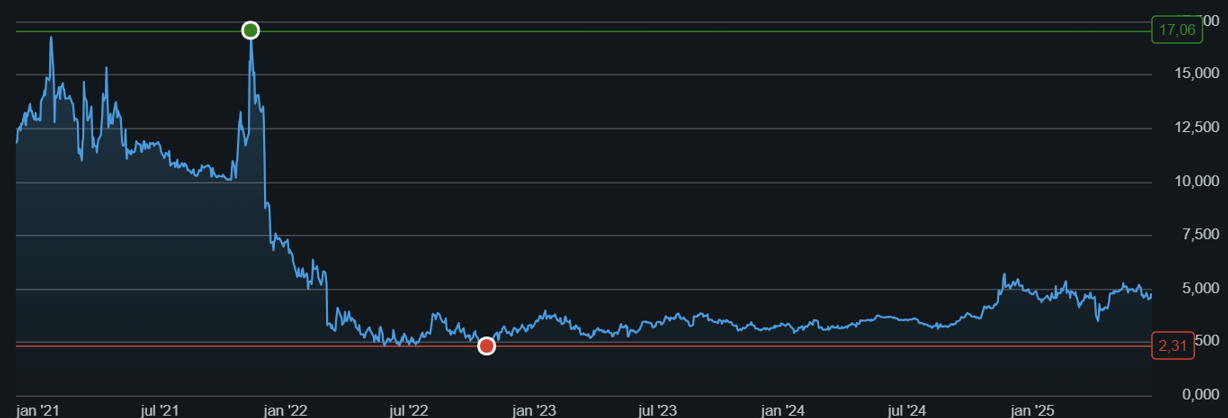 Grab Holding share price performance over the past five years.
Grab Holding share price performance over the past five years.
HelloFresh
On June 7, 2024, we took our first position in HelloFresh at a price of €5.66. We bought 250 shares, seeing in the company a promising turnaround with strong leverage on operational improvements. At that point, HelloFresh had been punished by the market due to disappointing growth figures, but we focused on the improved cost base and the rapidly expanding Ready-to-Eat segment as key recovery catalysts.
Our thesis played out quickly: in September 2024, we sold part of the position with a 54% gain, and in December 2024 we exited the remainder with an impressive 114% gain. Our €13 price target was achieved in less than six months.
Following this spectacular rally, the share price dropped below €8 in the first half of 2025. This correction offered another opportunity. Despite weaker revenue forecasts—the company even expected a slight decline—margins had clearly improved. We saw HelloFresh setting the right priorities: cost savings, cash flow maximization, and selective growth. Profitability exceeded expectations, and the company continued to focus on its fast-growing Ready-to-Eat division, now representing over a quarter of total revenue.
In June 2025, we added another 150 HelloFresh shares to our portfolio at around €7.78. Not a big bet, but a promising move in an uncertain market climate.
HelloFresh’s financial foundation is solid: net debt stands at just €0.4 billion, equating to a conservative net debt/EBITDA ratio of 1.1x. In addition, the share buyback program was extended with another €75 million—enough to repurchase over 5% of outstanding shares at current prices, signaling confidence and capital efficiency.
Also noteworthy: in September 2024, CEO Dominik Richter made a strong statement by purchasing €10 million worth of shares, raising his stake to 5%. We view this kind of founder-CEO commitment very positively.
Though the revenue outlook has weakened, the stock remains attractively valued, with a projected P/E of 8.0x in 2027 and an EV/FCF multiple of 7.8x. For a company with dominant market positions, a proven brand, and improving margins, that is low in our view.
We maintain our buy rating on HelloFresh, with a renewed price target of €13. This is based not only on past price movements, but also on fundamental improvements in cash flow, balance sheet, and strategy. HelloFresh fits perfectly into our philosophy: undervalued growth stocks with upside potential that the market has yet to fully price in.
 Hello Fresh share price performance over the past five years.
Hello Fresh share price performance over the past five years.
Brunel
On September 25, 2024, we initiated a full position of 400 Brunel shares at €8.70. We saw an overlooked opportunity in this Dutch staffing firm: despite strong revenue growth, the share price was at a level hardly justified even under recessionary conditions. And yet Brunel operates in growth markets like sustainable energy, engineering, and IT, with global diversification and a niche in highly skilled placements.
The share price has since moved sideways and remains near €8.70. However, we’re not seeing any fatigue: with a dividend yield of 6.4%—expected to rise to 7.1% in 2025—we are generously compensated for our patience. Waiting is supported by fundamental trends: the energy transition creates opportunities, gross margin is protected through cost savings, and large renewable energy projects provide a strong pipeline for 2025 and beyond.
Challenges remain: the German automotive sector remains weak, and some projects in Asia have been delayed. But with a €20 million cost-saving plan and digitalization initiatives improving operational efficiency, Brunel is working on structural profit improvements. Analysts expect double-digit EBIT growth in 2025, even if Germany stays weak.
We expect a price recovery toward our €14 target in the medium term, offering about 70% upside. Add to that a solid dividend, and you have an ideal position for patient investors. The stock is undervalued with a 2025 P/E of 8.3x—well below its historical average of 19x.
Moreover, with founder Jan Brand (age 75) still at the helm holding 60.05% of shares, a takeover or strategic restructuring cannot be ruled out. Until then, we enjoy the generous dividend while awaiting revaluation or consolidation in the sector.
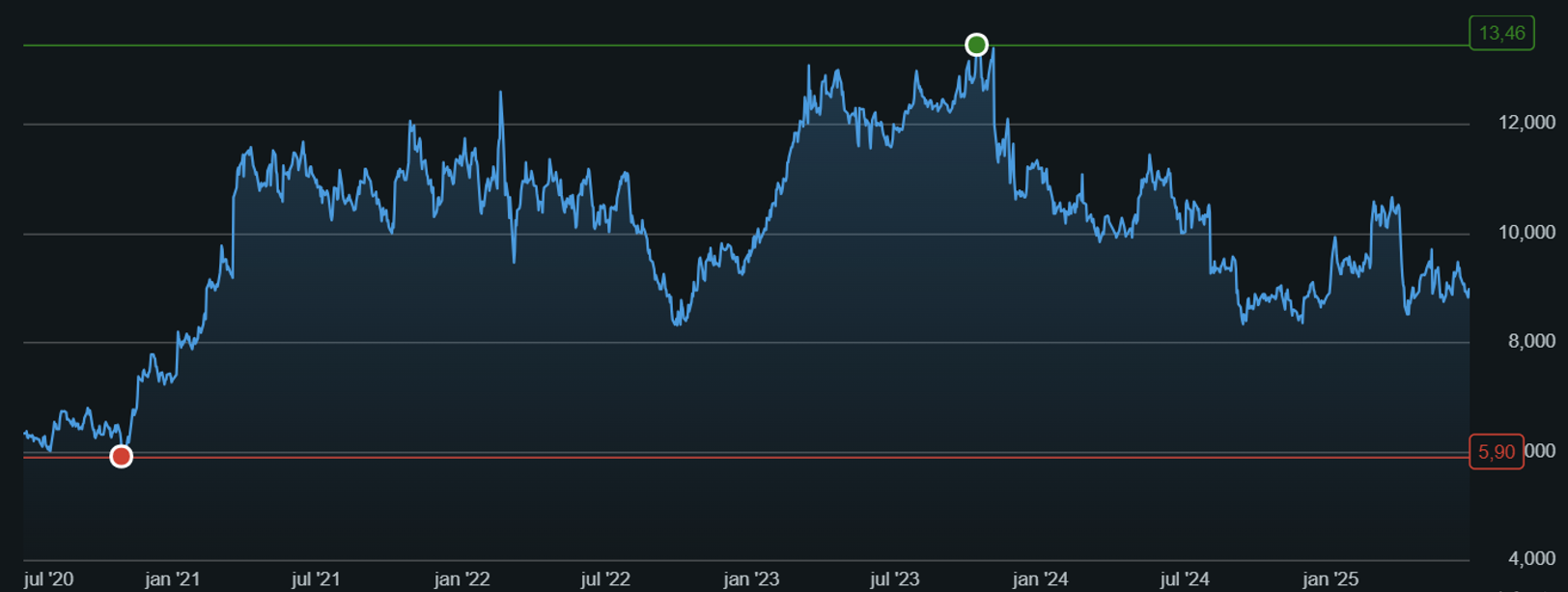 Brunel share price performance over the past five years.
Brunel share price performance over the past five years.
Centrica
On January 8, 2025, we took a modest position of 400 Centrica shares at £1.38. The stock had a difficult 2024, marked by volatility due to uncertainty around energy transition investments. Still, we saw enough reason for a cautious entry: the balance sheet was strong, the interim dividend was raised, and a £200 million buyback was underway. Centrica’s capital position allows for both growth and shareholder returns—a rare combination in a transitioning sector.
The share price now stands at £1.64, with our initial target of £1.75 nearly reached. That’s a 19% gain in under six months. This rise is not accidental: investors are gradually gaining confidence in Centrica’s role in the UK energy transition. A free cash flow of £0.8 billion in H1 2024 and a net cash position of £3.2 billion underscore the company’s financial strength.
The energy transition requires significant investment—Centrica plans up to £800 million per year through 2028—but the company has the means. As the only fully vertically integrated player in the UK energy sector, Centrica is uniquely positioned to add value across the chain: from production and storage to delivery and consumption.
That said, we remain cautious: Centrica Energy, the unit involved in production and trading, remains relatively opaque, limiting confidence in valuation. Also, the 2028 targets are ambitious and need to be met.
As long as the story holds and the numbers point in the right direction, we remain invested. We are monitoring the situation closely. If the £1.75 target is reached without a convincing improvement in outlook or results, we may take profits. But if Centrica proves its investments are paying off and free cash flow continues to grow, a revised price target is certainly on the table.
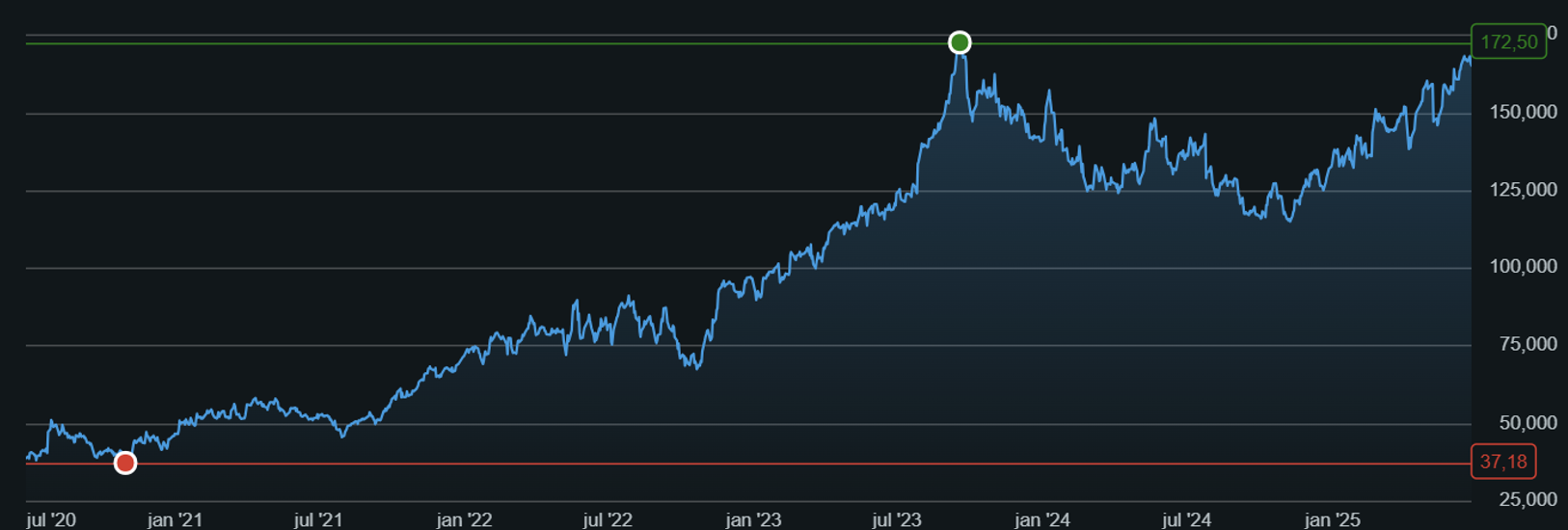 Centrica share price performance over the past five years.
Centrica share price performance over the past five years.
Playtech
On April 17, 2025, we took our first position in Playtech at around 740 pence. The trigger was exceptional: the company announced the sale of its entire stake in its B2C division Snaitech to Flutter Entertainment for £2.0 billion in cash. Of that amount, at least £1.45 billion would be returned to shareholders via a special dividend of around 550 pence per share—with no dilution.
For us, this was a rare and attractive opportunity: a significant portion of our investment would be returned almost immediately, while we retained a stake in the profitable and well-capitalized core business—its B2B division. This segment acts as a tech partner for online casinos and sports betting platforms and continues to grow robustly in regulated markets worldwide.
The dividend has since been paid out. As expected, the share price dropped on the ex-dividend date, but has since recovered and is now 24% higher, adjusted for the dividend. This recovery is no coincidence: the remaining B2B division performed strongly in 2024, with 10% revenue growth and a 22% increase in EBITDA—yielding a nearly 30% margin. Reliance on major clients has also decreased, making the business model more stable.
Strategically, Playtech is on track. It is investing in high-growth markets such as Canada, South Africa, France, Chile, and the UAE. Through the restructuring of its partnership with Caliente in Mexico, it gained a 30.8% stake in Cali Interactive—a new platform targeting the regulated U.S. online gaming market.
After the dividend payout, the remaining market value is about £800 million for a core business expected to generate £85 million in net profit in 2025. That implies a P/E ratio of under 10x, which is low for a high-margin, growth-oriented, globally diversified tech company. The fact that the dividend was paid entirely in cash and involved no new share issuance underscores management’s shareholder-friendly approach.
To us, Playtech is a textbook example of how a well-timed strategic reshuffle can create both immediate and future value. The stock remains one of our favorites within the Sharesunderten portfolio.
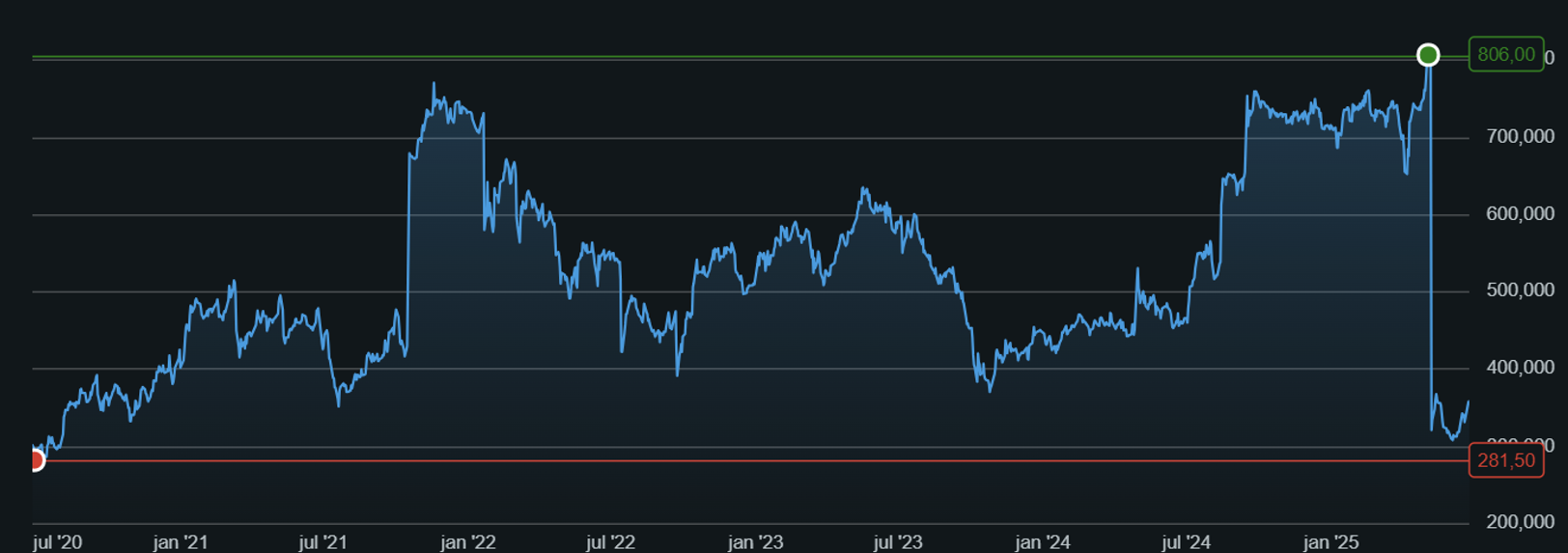 Playtech share price performance over the past five years.
Playtech share price performance over the past five years.
Conclusion
The past years have shown that patience, strategic insight, and a sharp eye for valuation can lead to impressive results—even in volatile markets. Whether it’s the structural transformation of BP, the hidden value in Deceuninck, or the technological revival of Rolls-Royce, each position in our Sharesunderten portfolio tells a unique story of recovery, resilience, or reinvention.
We continue to focus on undervalued growth stocks with strong balance sheets, improving cash flows, and a clear strategic direction. Our approach remains disciplined: we take profits when targets are reached, we stay alert for new entry points, and we hold on tightly when the long-term outlook remains intact.
As always, we are prepared to act swiftly when opportunities arise—but never without a solid fundamental basis. We believe that the current mix of companies in the portfolio offers a robust foundation for future returns.
Our conviction remains strong. The market often underestimates the power of steady improvement. We don’t. From this point forward, you’re part of the journey — and we’re actively searching for our next promising shareunderten



